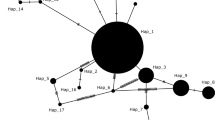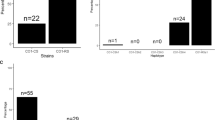Abstract
Two-spotted spider mite, Tetranychus urticae Koch (Acari: Tetranychidae), is a cosmopolitan pest species that can feed on more than 1000 host plant species. Historically, organophosphate (OP) and carbamate insecticides have been used to control this extremely polyphagous pest. However, its ability to develop acaricide resistance rapidly has led to failure in control. Mutations in acetylcholinesterase gene (ace), the target-site of OP and carbamate insecticides, have been reported to be one of the major mechanisms underlying this developing resistance. In this study, mutations previously associated with resistance (G119S, A201S, T280A, G328A, F331W/Y) in ace have been screened in 37 T. urticae populations collected across Turkey. All mutations were found in various populations, except G119S. Almost all populations had F331W/Y mutation (being fixed in 32 populations), whereas only two populations harboured A201S mutation, but not fixed. On the other hand, more than half of the populations contained T280A and G328A mutations. In addition, the presence of same haplotypes in populations originating from distinct geographic locations and a wide variety of ace haplotypes might indicate multiple origins of F331W and F331Y mutations; however, this needs further investigation. The results of area-wide screening showed that ace mutations are widely distributed among T. urticae populations. Therefore, the use of this group of insecticides should be limited or only rotational use might be regarded as a resistance management tool due to its different mode of action from other main acaricide groups in T. urticae control across Turkey.



Similar content being viewed by others
References
Adesanya AW, Lavine MD, Moural TW, Lavine LC, Zhu F, Walsh DB (2021) Mechanisms and management of acaricide resistance for Tetranychus urticae in agroecosystems. J Pest Sci 94:639–663. https://doi.org/10.1007/s10340-021-01342-x
Anazawa Y, Tomita T, Aiki Y, Kozaki T, Kono Y (2003) Sequence of a cDNA encoding acetylcholinesterase from susceptible and resistant two-spotted spider mite, Tetranychus urticae. Insect Biochem Mol Biol 33(5):509–514. https://doi.org/10.1016/S0965-1748(03)00025-0
Anber HAI, Overmeer WPJ (1988) Resistance to organophosphates and carbamates in the predacious mite Amblyseius potentillae (Garman) due to insensitive acetylcholinesterase. Pestic Biochem Phys 31(1):91–98. https://doi.org/10.1016/0048-3575(88)90033-8
Andreev D, Kreitman M, Phillips TW, Beeman RW (1999) Multiple origins of cyclodiene insecticide resistance in Tribolium castaneum (Coleoptera: Tenebrionidae). J Mol Evol 48(5):615–624. https://doi.org/10.1007/pl00006504
Andrews M, Callaghan A, Field LM, Williamson MS, Moores GD (2004) Identification ofmutations conferring insecticide-insensitive AChE in the cotton-melon aphid, Aphis gossypii Glover. Insect Mol Biol 13:555–561. https://doi.org/10.1111/j.0962-1075.2004.00517.x
Anstead JA, Williamson MS, Denholm I (2005) Evidence for multiple origins of identical insecticide resistance mutations in the aphid Myzus persicae. Insect Biochem Mol Biol 35(3):249–256. https://doi.org/10.1016/j.ibmb.2004.12.004
Ay R (2005) Determination of susceptibility and resistance of some greenhouse populations of Tetranychus urticae Koch to chlorpyrifos (Dursban 4) by the petri dish–Potter tower method. J Pest Sci 78(3):139–143. https://doi.org/10.1007/s10340-005-0084-7
Casida JE (2004) Organophosphate toxicology: safety aspects of nonacetylcholinesterase secondary targets. Chem Res Toxicol 17:983–998. https://doi.org/10.1021/tx0499259
Cheung J, Mahmood A, Kalathur R, Liu L, Carlier PR (2018) Structure of the G119S mutant acetylcholinesterase of the malaria vector Anopheles gambiae reveals basis of insecticide resistance. Structure 26(1):130–136. https://doi.org/10.1016/j.str.2017.11.021
Colovic MB, Krstic DZ, Lazarevic-Pasti TD, Bondzic AM, Vasic VM (2013) Acetylcholinesterase inhibitors: pharmacology and toxicology. Curr Neuropharmacol 11:315–335. https://doi.org/10.2174/1570159X11311030006
Djogbénou L, Dabiré R, Diabaté A, Kengne P, Akogbéto M, Hougard JM, Chandre F (2008) Identification and geographic distribution of the ACE-1R mutation in the malaria vector Anopheles gambiae in south-western Burkina Faso, West Africa. Am J Trop Med Hyg 78(2):298–302. https://doi.org/10.4269/ajtmh.2008.78.298
Elfekih S, Shannon M, Haran J, Vogler AP (2014) Detection of the acetylcholinesterase insecticide resistance mutation (G328A) in natural populations of Ceratitis capitata. J Econ Entomol 107(5):1965–1968. https://doi.org/10.1603/EC14166
Essandoh J, Yawson AE, Weetman D (2013) Acetylcholinesterase (Ace-1) target site mutation 119S is strongly diagnostic of carbamate and organophosphate resistance in Anopheles gambiae s.s. and Anopheles coluzzii across southern Ghana. Malar J 12(1):1–10. https://doi.org/10.1186/1475-2875-12-404
Gupta RC, Mukherjee IRM, Malik JK, Doss RB, Dettbarn WD, Milatovic D (2019) Insecticides. In: Gupta R (ed) Biomarkers in toxicology, 2nd edn. Academic Press, Boca Raton, pp 455–475
Haddi K, Berger M, Bielza P, Rapisarda C, Williamson MS, Moores G, Bass C (2017) Mutation in the ace-1 gene of the tomato leaf miner (Tuta absoluta) associated with organophosphates resistance. J Appl Entomol 141:612–619. https://doi.org/10.1111/jen.12386
Hawkins NJ, Bass C, Dixon A, Neve P (2019) The evolutionary origins of pesticide resistance. Biol Rev 94(1):135–155. https://doi.org/10.1111/brv.12440
Hsu J-C, Haymer DS, Wu W-J, Feng H-T (2006) Mutations in the acetylcholinesterase gene of Bactrocera dorsalis associated with resistance to organophosphorus insecticides. Insect Biochem Mol Biol 36:396–402. https://doi.org/10.1016/j.ibmb.2006.02.002
IARC (2017) Some organophosphate insecticides and herbicides. International Agency for Research on Cancer, Lyon
Ilias A, Vontas J, Tsagkarakou A (2014) Global distribution and origin of target site insecticide resistance mutations in Tetranychus urticae. Insect Biochem Mol Biol 48:17–28. https://doi.org/10.1016/j.ibmb.2014.02.006
İnak E, Alpkent YN, Çobanoğlu S, Dermauw W, Van Leeuwen T (2019) Resistance incidence and presence of resistance mutations in populations of Tetranychus urticae from vegetable crops in Turkey. Exp Appl Acarol 78(3):343–360. https://doi.org/10.1007/s10493-019-00398-w
Katoh K, Rozewicki J, Yamada KD (2019) MAFFT online service: multiple sequence alignment, interactive sequence choice and visualization. Brief Bioinformatics 20(4):1160–1166. https://doi.org/10.1093/bib/bbx108
Khajehali J, Van Leeuwen T, Grispou M, Morou E, Alout H, Weill M, Tirry L, Vontas J, Tsagkarakou A (2010) Acetylcholinesterase point mutations in European strains of Tetranychus urticae (Acari: Tetranychidae) resistant to organophosphates. Pest Manag Sci 66:220–228. https://doi.org/10.1002/ps.1884
Kumar S, Stecher G, Li M, Knyaz C, Tamura K (2018) MEGA X: molecular evolutionary genetics analysis across computing platforms. Mol Biol Evol 35(6):1547. https://doi.org/10.1093/molbev/msy096
Kumral NA, Susurluk H, Gençer NS, Gürkan MO (2009) Resistance to chlorpyrifos and lambda-cyhalothrin along with detoxifying enzyme activities in field-collected female populations of European red mite. Phytoparasitica 37(1):7–15. https://doi.org/10.1007/s12600-008-0007-2
Kwon DH, Im JS, Ahn JJ, Lee JH, Clark JM, Lee SH (2010) Acetylcholinesterase point mutations putatively associated with monocrotophos resistance in the two-spotted spider mite. Pestic Biochem Physiol 96(1):36–42. https://doi.org/10.1016/j.pestbp.2009.08.013
Kwon DH, Choi JY, Je YH, Lee SH (2012) The overexpression of acetylcholinesterase compensates for the reduced catalytic activity caused by resistance-conferring mutations in Tetranychus urticae. Insect Biochem Mol Biol 42(3):212–219. https://doi.org/10.1016/j.ibmb.2011.12.003
Lee D-W, Choi JY, Kim WT, Je YH, Song JT, Chung BK, Saeng Boo K, Ho Koh Y (2007) Mutations of acetylcholinesterase1 contribute to prothiofos-resistance in Plutella xylostella (L.). Biochem Biophys Res Commun 353:591–597. https://doi.org/10.1016/j.bbrc.2006.12.088
Lee SH, Kim YH, Kwon DH, Cha DJ, Kim JH (2015) Mutation and duplication of arthropod acetylcholinesterase: implications for pesticide resistance and tolerance. Pestic Biochem Physiol 120:118–124. https://doi.org/10.1016/j.pestbp.2014.11.004
Leigh JW, Bryant D (2015) popart: full-feature software for haplotype network construction. Methods Ecol Evol 6(9):1110–1116. https://doi.org/10.1111/2041-210X.12410
Lenfant N, Hotelier T, Velluet E, Bourne Y, Marchot P, Chatonnet A (2012) ESTHER, the database of the α/β-hydrolase fold superfamily of proteins: tools to explore diversity of functions. Nucleic Acids Res 41(D1):D423–D429. https://doi.org/10.1093/nar/gks1154
Magaña C, Hernández-Crespo P, Brun-Barale A, Couso-Ferrer F, Bride JM, Castañera P, Feyereisen R, Ortego F (2008) Mechanisms of resistance to malathion in the medfly Ceratitis capitata. Insect Biochem Mol Biol 38(8):756–762. https://doi.org/10.1016/j.ibmb.2008.05.001
Menozzi P, Shi MA, Lougarre A, Tang ZH, Fournier D (2004) Mutations of acetylcholinesterase which confer insecticide resistance in Drosophila melanogaster populations. BMC Evol Biol 4(1):1–7. https://doi.org/10.1186/1471-2148-4-4
Migeon A, Dorkeld F (2021) Spider Mites Web: a comprehensive database for the Tetranychidae. http://www1.montpellier.inra.fr/CBGP/spmweb accessed 17 June 2021
Mota-Sanchez D, Wise JC (2021) The Arthropod Pesticide Resistance Database. Michigan State University. http://www.pesticideresistance.org
Okonechnikov K, Golosova O, Fursov M, Ugene Team (2012) Unipro UGENE: a unified bioinformatics toolkit. Bioinformatics 28(8):1166–1167. https://doi.org/10.1093/bioinformatics/bts091
Pinto J, Lynd A, Vicente JL, Santolamazza F, Randle NP, Gentile G, Moreno M, Simard F, Charlwood JD, do Rosário VE, Caccone A, della Torre A, Donnelly MJ (2007) Multiple origins of knockdown resistance mutations in the Afrotropical mosquito vector Anopheles gambiae. PLoS ONE 2(11):e1243. https://doi.org/10.1371/journal.pone.0001243
Rozas J, Ferrer-Mata A, Sánchez-DelBarrio JC, Guirao-Rico S, Librado P, Ramos-Onsins SE, Sánchez-Gracia A (2017) DnaSP 6: DNA sequence polymorphism analysis of large data sets. Mol Biol Evol 34(12):3299–3302. https://doi.org/10.1093/molbev/msx248
Russell RJ, Claudianos C, Campbell PM, Horne I, Sutherland TD, Oakeshott JG (2004) Two major classes of target site insensitivity mutations confer resistance to organophosphate and carbamate insecticides. Pestic Biochem Physiol 79(3):84–93. https://doi.org/10.1016/j.pestbp.2004.03.002
Simma EA, Hailu B, Jonckheere W, Rogiers C, Duchateau L, Dermauw W, Van Leeuwen T (2020) Acaricide resistance status and identification of resistance mutations in populations of the two-spotted spider mite Tetranychus urticae from Ethiopia. Exp Appl Acarol 82(4):475–491. https://doi.org/10.1007/s10493-020-00567-2
Smissaert HR (1964) Cholinesterase inhibition in spider mites susceptible and resistant to organophosphate. Science 143(3602):129–131. https://doi.org/10.1126/science.143.3602.129
Sparks TC, Nauen R (2015) Mode of action classification and insecticide resistance management. Pestic Biochem Physiol 121:122–128. https://doi.org/10.1016/j.pestbp.2014.11.014
Sparks TC, Crossthwaite AJ, Nauen R, Banba S, Cordova D, Earley F, Ebbinghaus-Kintscher U, Fujioka S, Hirao A, Karmon D, Kennedy R, Nakao T, Popham HJ, Salgado V, Watson GB, Wedel BJ, Wessels FJ (2020) Insecticides, biologics and nematicides: Updates to IRAC’s mode of action classification-a tool for resistance management. Pestic Biochem Physiol 167:104587. https://doi.org/10.1016/j.pestbp.2020.104587
Van de Baan HE, Kuijpers LAM, Overmeer WPJ, Oppenoorth FJ (1985) Organophosphorus and carbamate resistance in the predacious mite Typhlodromus pyri due to insensitive acetylcholinesterase. Exp Appl Acarol 1(1):3–10. https://doi.org/10.1016/0048-3575(88)90033-8
Van Leeuwen T, Dermauw W (2016) The molecular evolution of xenobiotic metabolism and resistance in chelicerate mites. Annu Rev Entomol 61:475–498. https://doi.org/10.1146/annurev-ento-010715-023907
Van Leeuwen T, Vontas J, Tsagkarakou A, Tirry L (2009) Mechanisms of acaricide resistance in the two-spotted spider mite Tetranychus urticae. In: Ishaaya I, Horowitz (eds) Biorational control of arthropod pests. Springer, Dordrecht, pp 347–393
Van Leeuwen T, Vontas J, Tsagkarakou A, Dermauw W, Tirry L (2010) Acaricide resistance mechanisms in the two-spotted spider mite Tetranychus urticae and other important Acari: a review. Insect Biochem Mol Biol 40(8):563–572. https://doi.org/10.1016/j.ibmb.2010.05.008
Van Leeuwen T, Dermauw W, Mavridis K, Vontas J (2020) Significance and interpretation of molecular diagnostics for insecticide resistance management of agricultural pests. Curr Opin Insect Sci 39:69–76. https://doi.org/10.1016/j.cois.2020.03.006
Walsh SB, Dolden TA, Moores GD, Kristensen M, Lewis T, Devonshire AL, Williamson MS (2001) Identification and characterization of mutations in housefly (Musca domestica) acetylcholinesterase involved in insecticide resistance. Biochem J 359:175e181. https://doi.org/10.1042/0264-6021:3590175
Weetman D, Mitchell SN, Wilding CS, Birks DP, Yawson AE, Essandoh J, Mawejje HD, Djogbenou LS, Steen K, Rippon EJ, Clarkson CS, Field SG, Rigden DJ, Donnelly MJ (2015) Contemporary evolution of resistance at the major insecticide target site gene Ace-1 by mutation and copy number variation in the malaria mosquito Anopheles gambiae. Mol Ecol 24(11):2656–2672. https://doi.org/10.1111/mec.13197
Weill M, Lutfalla G, Mogensen K, Chandre F, Berthomieu A, Berticat C, Pasteur N, Philips A, Fort P, Raymond M (2003) Insecticide resistance in mosquito vectors. Nature 423(6936):136–137. https://doi.org/10.1038/423136b
Xu D, He Y, Zhang Y, Xie W, Wu Q, Wang S (2018) Status of pesticide resistance and associated mutations in the two-spotted spider mite, Tetranychus urticae, in China. Pestic Biochem Physiol 150:89–96. https://doi.org/10.1016/j.pestbp.2018.07.008
Yang C, Feng X, Huang Z, Li M, Qiu X (2016) Diversity and frequency of kdr mutations within Anopheles sinensis populations from Guangxi, China. Malar J 15(1):1–8. https://doi.org/10.1186/s12936-016-1467-3
Yang C, Feng X, Liu N, Li M, Qiu X (2019) Target-site mutations (AChE-G119S and kdr) in Guangxi Anopheles sinensis populations along the China–Vietnam border. Parasit Vectors 12(1):1–7. https://doi.org/10.1186/s13071-019-3298-x
Zhang Y, Xu D, Zhang Y, Wu Q, Xie W, Guo Z, Wang S (2021) Frequencies and mechanisms of pesticide resistance in Tetranychus urticae field populations in China. Insect Sci. https://doi.org/10.1111/1744-7917.12957
Author information
Authors and Affiliations
Corresponding author
Additional information
Publisher’s Note
Springer Nature remains neutral with regard to jurisdictional claims in published maps and institutional affiliations.
Supplementary Information
Below is the link to the electronic supplementary material.
Rights and permissions
About this article
Cite this article
İnak, E. Geographical distribution and origin of acetylcholinesterase mutations conferring acaricide resistance in Tetranychus urticae populations from Turkey. Exp Appl Acarol 86, 49–59 (2022). https://doi.org/10.1007/s10493-021-00673-9
Received:
Accepted:
Published:
Issue Date:
DOI: https://doi.org/10.1007/s10493-021-00673-9




